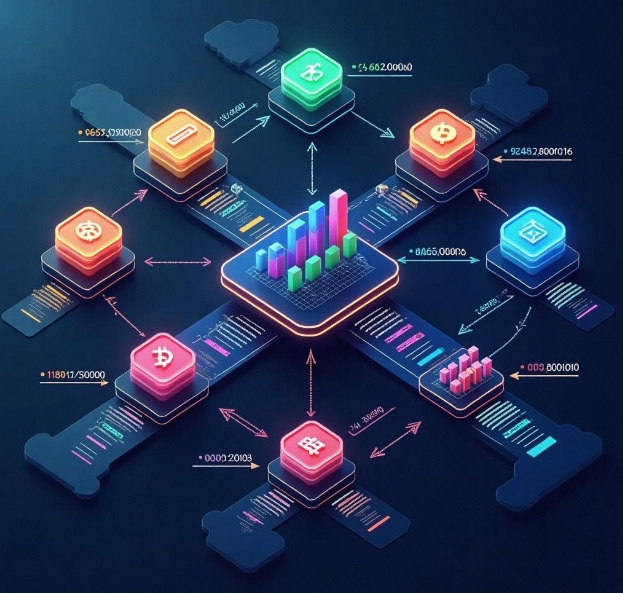Analysis of Cross-Chain Technology: How Do Web3 Applications Achieve Multi-Chain Interaction?
- latest articles
- 1.DApp Development & Customization: Merging Diverse Market Needs with User Experience 2.Analysis of the Core Technical System in DApp Project Development 3.How to achieve cross-chain interoperability in Web3 projects? 4.How does the tokenization of points reconstruct the e-commerce ecosystem? 5.How to Set and Track Data Metrics for a Points Mall? 6.What is DApp Development? Core Concepts and Technical Analysis 7.Inventory of commonly used Web3 development tools and usage tips 8.Development of a Distribution System Integrated with Social E-commerce 9.Six Key Steps for Businesses to Build a Points Mall System 10.What is DApp Development? A Comprehensive Guide from Concept to Implementation
- Popular Articles
- 1.Future Trends and Technology Predictions for APP Development in 2025 2.Analysis of the DeFi Ecosystem: How Developers Can Participate in Decentralized Finance Innovation 3.From Zero to One: How PI Mall Revolutionizes the Traditional E-commerce Model 4.DAPP Development | Best Practices for Professional Customization and Rapid Launch 5.Recommended by the Web3 developer community: the most noteworthy forums and resources 6.From Cloud Computing to Computing Power Leasing: Building a Flexible and Scalable Computing Resource Platform 7.How to Develop a Successful Douyin Mini Program: Technical Architecture and Best Practices 8.Shared Bike System APP: The Convenient Choice in the Era of Smart Travel 9.How to Create a Successful Dating App: From Needs Analysis to User Experience Design 10.From Design to Development: The Complete Process of Bringing an APP Idea to Life
In the rapid development of blockchain technology, cross-chain technology, as a crucial solution for interoperability between blockchains, has become a hot topic in the Web3 application field. With the continuous expansion of blockchain applications, the limitations of single blockchain networks are increasingly apparent. How to achieve the free flow of assets, data, and information across multiple blockchains has become one of the core issues in the Web3 ecosystem. The emergence of cross-chain technology aims to address this problem, driving the further maturity and application of blockchain technology.
I. Background and Demand for Cross-Chain Technology
1.1 The Blockchain Island Phenomenon
Although blockchain technology has made significant progress in recent years, current blockchain networks still face the limitation of incompatibility. Each blockchain network is like an "island," with no direct connection or interaction between them. In this scenario, users or developers are often forced to choose a single blockchain network to implement their applications, leading to issues such as uneven resource distribution and closed ecosystems.
For example, major blockchain platforms like Ethereum, Bitcoin, and Binance Smart Chain (BSC) each have unique advantages, but they cannot directly communicate with each other. This results in the fragmentation of resources, assets, and data between blockchains. When transferring assets or exchanging information across different blockchains, users not only rely on centralized exchange platforms (such as exchanges) but may also face issues like high transaction fees and long confirmation times.
1.2 The Multi-Chain Demand of Web3
As a decentralized internet protocol, Web3 advocates for greater user control and data ownership. The fundamental goal of Web3 applications is to achieve true decentralization, which cannot be realized without the support of cross-chain technology. This is because Web3 applications need to freely interact, exchange assets, and share information across multiple blockchain networks to build a more open and diverse ecosystem.
For instance, decentralized finance (DeFi) applications may require liquidity from different blockchains, while decentralized identity verification systems may need to retrieve validation information from multiple blockchains. Without cross-chain technology, Web3 applications would struggle to achieve seamless interaction across multiple chains, severely limiting their functionality.
II. Principles and Implementation Methods of Cross-Chain Technology
Cross-chain technology enables interoperability between different blockchains through various mechanisms. There are multiple ways to achieve cross-chain functionality, primarily categorized into the following technical approaches:
2.1 Relay Chains and Bridge Chains
Relay chains and bridge chains are common methods for implementing cross-chain functionality. In this architecture, a main chain (relay chain) connects multiple sub-chains (bridge chains), ensuring the security and validity of cross-chain transactions through the relay chain's consensus mechanism. The relay chain typically does not handle actual business logic but acts as a coordinator between different blockchains.
For example, the Polkadot network employs a relay chain and bridge chain architecture. Polkadot's relay chain is responsible for maintaining the security and coordination of the entire ecosystem, while individual parachains can execute specific smart contracts or applications based on their needs. Through Polkadot's Cross-Chain Message Passing (XCMP) protocol, different parachains can communicate and exchange information, achieving multi-chain interoperability.
2.2 Off-Chain Protocols and Sidechains
Off-chain protocols and sidechains represent another technical approach to achieving cross-chain functionality. A sidechain is a blockchain that runs parallel to the main chain, synchronized with the main chain through a specific mechanism and capable of interacting with other blockchains via smart contracts. The advantage of sidechain technology lies in its ability to handle more computational demands without directly impacting the performance of the main chain.
For instance, cross-chain interactions between Bitcoin and Ethereum often rely on sidechain technology. Through a sidechain, users can initiate transactions on the Bitcoin network, lock Bitcoin assets on the sidechain, and then interact with the Ethereum network via the sidechain, enabling cross-chain transfers.
Off-chain protocols facilitate cross-chain interactions through off-chain methods. These protocols establish an intermediary layer to transfer information and assets between different blockchains. The advantage of off-chain protocols is that they reduce the computational load on the chain and enable data exchange between different blockchains.
2.3 Decentralized Exchange Protocols (DEX)
Decentralized exchange protocols (DEX) are widely used in Web3 multi-chain interactions as a form of cross-chain technology. Through decentralized exchanges, users can directly exchange assets across multiple blockchains without relying on centralized platforms. Decentralized exchange protocols typically depend on cross-chain technology to ensure the secure and low-cost flow of assets between different blockchains.
For example, cross-chain DEX protocols like Thorchain allow users to directly exchange assets across multiple blockchains, including Bitcoin, Ethereum, and Binance Smart Chain. This enables users to convert assets between different blockchains without relying on centralized platforms.
III. Challenges and Solutions in Cross-Chain Technology
Although cross-chain technology theoretically enables multi-chain interactions, it still faces several challenges in practical applications:
3.1 Security Issues
Cross-chain transactions involve the collaboration of multiple blockchain systems, making security a significant challenge. For instance, during cross-chain asset transfers, how can users ensure their assets are not stolen or lost before the transaction is completed? How can malicious attacks exploiting cross-chain vulnerabilities be prevented?
To address this issue, many cross-chain protocols employ technologies such as multi-signature and threshold signatures to ensure the security of cross-chain transactions. Additionally, some cross-chain protocols introduce consensus mechanisms, incorporating third-party audit nodes or security measures to further enhance the safety of cross-chain transactions.
3.2 Cross-Chain Compatibility Issues
Different blockchains have varying protocols, consensus mechanisms, and technical architectures, posing significant technical challenges for cross-chain compatibility. Achieving seamless data exchange and asset flow between different blockchains is a key difficulty in cross-chain technology.
One solution to this problem is the adoption of standardized protocols for cross-chain interoperability. For example, Cosmos's Inter-Blockchain Communication (IBC) protocol provides a standardized communication protocol between different blockchains, ensuring interconnectivity. Through such standardized protocols, blockchains can achieve efficient and low-cost cross-chain interactions.
3.3 Transaction Speed and Cost Issues
Cross-chain transactions involve interactions and confirmations across multiple blockchains, often resulting in longer confirmation times and higher transaction costs. Especially when processing a large volume of cross-chain transactions on-chain, improving transaction speed and reducing costs is another major challenge for cross-chain technology.
To address this issue, many cross-chain technologies utilize off-chain protocols and sidechain technology to reduce the on-chain transaction load and improve cross-chain efficiency. Additionally, by introducing more efficient consensus mechanisms (such as DPoS, BFT, etc.), cross-chain transaction confirmation times can be effectively reduced, lowering transaction costs.
IV. Future Development of Cross-Chain Technology
The continuous evolution of cross-chain technology is driving the development of the Web3 ecosystem. In the future, with technological advancements and the refinement of standardized protocols, cross-chain technology will find broader applications across various fields.
4.1 Enhanced Interoperability
Future cross-chain technology will further improve interoperability between blockchains, supporting more blockchain networks and application scenarios. For example, through standardized cross-chain protocols, users will be able to exchange assets and share information more conveniently across different blockchains.
4.2 Cross-Chain Privacy Protection
With the continuous development of decentralized finance (DeFi) and decentralized applications (DApps), privacy protection is increasingly gaining attention. Future cross-chain technology will ensure the secure flow of data and assets across multiple blockchains while protecting user privacy. Technologies like zero-knowledge proofs (ZKPs) will provide better guarantees for the privacy of cross-chain transactions.
4.3 Cross-Chain Governance
Cross-chain governance will become an important direction for the future development of cross-chain technology. As blockchain networks diversify, ensuring governance coordination between different blockchains and avoiding conflicts has become a critical issue for cross-chain technology. Future cross-chain protocols will introduce more intelligent governance mechanisms, making collaboration between different blockchains more efficient and fair.
V. Conclusion
The continuous development of cross-chain technology has enhanced the multi-chain interaction capabilities of Web3 applications, gradually forming a decentralized ecosystem. Although cross-chain technology still faces challenges, ongoing innovation and breakthroughs will expand its application scenarios, making the future Web3 ecosystem more open and interconnected. The widespread adoption of cross-chain technology not only provides stronger support for decentralized applications but also lays a solid foundation for the long-term development of blockchain.
-

How to achieve cross-chain interoperability in Web3 projects?
With the continuous development of WEB3 technology, Web3 has gradually become an···
-

Inventory of commonly used Web3 development tools and usage tips
With the continuous development of blockchain technology, Web3 has become a hot ···
-

Web3 development trend prediction: analysis of future technology directions and application scenarios
With the gradual development of blockchain technology, the concept of Web3 has m···

 Blockchain
Blockchain












